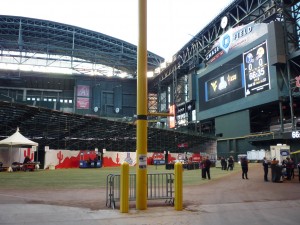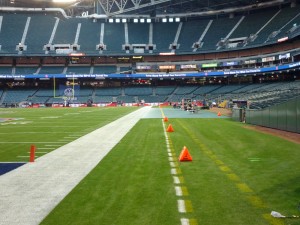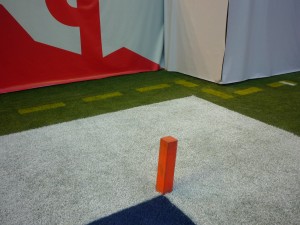WVU v. Arizona State: Cactus bowl of fun
January 2, 2016 by Mike Casazza
You are looking live at the today’s rendering at Chase Field, sight of the 27th annual Cactus Bowl. We’re at a baseball stadium, and we’ve done this before. It did not go well.
This looks and feels different, and it’s important to note football games in baseball stadiums are not as new as they were three postseasons ago. Hosts are better at configuring the place, and the fact there’s no chance of a blizzard is gravy.
We like the looks of this, though. Let’s look a little closer.

This is what’s ordinarily the right field corner, now behind the grandstands along the Arizona State sideline. Today’s capacity is going to be 48,000, which is about 1,000 less than the normal capacity. They’ve only covered up a few sections and mitgated that by adding a few closer to the field.
The problem with baseball fields and football games, though, is with the space. You’re going to have some tight spots. Look again at the birdseye view from before the jump. The “E” in “State” in the end zone is near home plate, which means they’ve laid real grass the field over where the infeld would be. They’ve found the spot in the stadium that allows for 120-plus vertical yards. They didn’t just paint stripes in the outfield and make the teams play over some dirt here and there.
Baseball stadiums are quirky with weird angles on the foul lines and in the outfield, and Chase Field is no exception. They’ve done a pretty good job here.

That’s the WVU sideline, and you can see there’s plenty of space. But this isn’t to say it’s without concerns.
Here’s the Mountaineers end zone.

Plays in the back of the end zone might be tricky, and consider the photographers who have to stay behind the yellow line will make that a bit more confined. The right corner is a little concerning, too, if either team plans to visit the eastern shore of Bolivia.

While we’re on the topic, let’s talk about passing, because I’ll be honest: I don’t see a way WVU wins tonight without a large day from Skyler Howard and some receivers. The Mountaineers, never ones to divulge much of anything, let alone a game plan, more or less agree with this.
“The nature of what they do defensively gives you probably lower completion percentage chances but greater potential for big plays,” Mountaineers coach Dana Holgorsen said. “They give up big plays in the secondary because they’re all spaced out due to the fact they put the majority of their players in the backfield to stop the run.
The Sun Devils, you have probably heard, blitz frequently. Far more than they don’t. But in doing so, by committing six or seven people to the line of scrimmage, they’re quite good at stopping the run. They held five Pac-12 teams under 100 yards rushing, four of them in succession.
But do the math and you know what that does to the defense. Nobody allowed more passing yard per game. Arizona State allowed 30 touchdown passes and 40 passing plays of 25 yards or more, a total topped only by Tulsa, which needed a bowl game to get to 42. WVU has to put the Sun Devils back at the bottom — in, like, the first quarter.
This is what 12 teams have done to the Sun Devils, and note the win/loss splits. There are no road maps or blueprints, or the Sun Devils would be 0-12, but there are cues.
And, again, WVU knows this and mostly admits this. The trouble is the Mountaineers have the problem of being less-than-great with vertical passes, sometimes at the mercy of drops and other times unable to adequately protect the quarterback. Still, WVU has to hit some … home runs … tonight and catch quick passes and make sizable gains.
“There’s no doubt we have to get the ball from Point A to Point B,” said quarterback Skyler Howard, whose only 300-yard passing game this season was in the opener and who had only two games with multiple touchdown passes in Big 12 play.
“That’s a big point of emphasis. When you’ve got seven guys coming at you, you’ve only got four more on the back end. That can help us in the passing game. We’ve just got to get the thing off.”
The trouble for the Mountaineers (7-5) is how many times opponents have been able to generate consistent pressure and affect Howard. They’ve allowed 30 sacks and rank No. 91 nationally by allowing 2.5 per game.
Howard won’t have a wealth of time to let routes develop down the field, and Holgorsen said WVU has to find ways to turn quick throws into big gains because “they don’t give you routine plays.”
“Even if they’re low-percentage passes like fade routes down the field, you’ve got to make a couple of those plays,” he said. “A couple of those plays will turn into points. Underneath stuff, when they pressure so much and you’ve got to sight-adjust some routes, those are tough catches, but you’ve got to pick up your feet and make guys miss.
“Catch-and-runs are what’s important. You’ve got to catch the ball underneath, slip a tackle or break a tackle and pick your feet up and go from there.”

